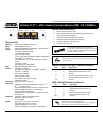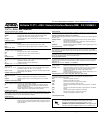
NetVanta T1/FT1 + DSX-1 Network Interface Module (NIM) P/N 1202863L1
For more detailed documentation, visit us online at www.adtran.com.
Quick Start Guide
®
Quick Start Guide, 61202863L1-13D, November 2006 Copyright © 2006 ADTRAN, All Rights Reserved
T1/FT1 + DSX-1 NIM COMMANDS
clock source [internal | line* | through]
Configures the source timing used for the interface. Use the no form of this command to return to the
default value.
internal Configures the unit to provide clocking using the internal oscillator.
line* Configures the unit to recover clocking from the T1 circuit.
through Configures the unit to recover clocking from the circuit connected to the
DSX-1 interface.
coding [ami | b8zs*]
Configures the line coding for a T1 physical interface. This setting must match the line coding supplied
on the circuit by the service provider.
ami Configures the line coding for alternate mark inversion (AMI).
b8zs
*
Configures the line coding for bipolar eight zero substitution (B8ZS).
fdl [ansi* | att | none]
Configures the format for the facility data link (FDL) channel on the T1 circuit. Use the no form of this
command to return to the default value.
ansi
*
Configures the FDL for ANSI T1.403 standard.
att Configures the FDL for AT&T TR 54016 standard.
none Disables FDL on this circuit.
framing [d4 | esf*]
Configures the framing format for the T1 interface. This parameter should match the framing format
supplied by your network provider. Use the no form of this command to return to the default value.
d4 Specifies D4 superframe (SF) format.
esf
*
Specifies extended superframe (ESF) format.
lbo [long <-22.5, -15, -7.5- 0> | short <0 to 655>]
Configures the line build out (LBO) for the T1 interface. Use the no form of this command to return to
the default value.
long <-22.5, -15, -7.5- 0> Configures the LBO (in dB) for T1 interfaces with cable lengths greater
than 655 feet. Choices are -22.5, -15, -7.5, and 0 dB.
short <0 to 655> Configures the LBO (in feet) for T1 interfaces with cable lengths less than
655 feet. Range is 0 to 655 feet.
loopback network [line | payload]
Initiates a loopback on the interface toward the network. Use the no form of this command to
deactivate the loopback.
line Initiates a metallic loopback of the physical T1 network interface.
payload Initiates a loopback of the T1 framer (CSU portion) of the T1 network
interface.
loopback remote line [fdl | inband]
Sends a loopback code to the remote unit to initiate a line loopback. Use the no form of this command
to send a loopdown code to the remote unit to deactivate the loopback.
fdl Uses the facility data link (FDL) to initiate a full 1.544 Mbps physical
(metallic) loopback of the signal received by the remote unit from the
network. (T1 interface only.)
inband Uses the inband channel to initiate a full 1.544 Mbps physical physical
(metallic) loopback of the signal received from the network.
loopback remote payload
Sends a loopback code to the remote unit to initiate a payload loopback. A payload loopback is a 1.536
Mbps loopback of the payload data received from the network maintaining bit-sequence integrity for
the information bits by synchronizing (regenerating) the timing. Use the no form of this command to
send a loopdown code to the remote unit to deactivate the loopback.
remote-alarm [rai]
Selects the alarm signaling type to be sent when a loss of frame is detected on the T1 receive signal.
Use the no form of this command to disable all transmitted alarms.
rai Specifies sending a remote alarm indication (RAI) in response to a loss of
frame. Also prevents a received RAI from causing a change in interface
operational status.
remote-loopback
Configures the interface to respond to loopbacks initiated by a remote unit (or service provider). Use
the no form of this command to disable this feature.
signaling-mode [message-oriented | none | robbed-bit*]
Configures the signaling type (robbed-bit for voice or clear channel for data) for the DS0s mapped to
the DSX-1 port.
message-oriented Specifies clear channel signaling on Channel 24 only. Use this signaling
type with QSIG installations.
none Specifies clear channel signaling on all 24 DS0s. Use this signaling type
with data-only or PRI DSX-1 installations.
robbed-bit* Specifies robbed bit signaling on all DS0s. Use this signaling type for voice-
only DSX-1 applications.
snmp trap line-status
Controls the Simple Network Management Protocol (SNMP) variable
dsx1LineStatusChangeTrapEnable (RFC2495) to enable (or disable) the interface to send SNMP
traps when there is an interface status change. Use the no form of this command to disable this trap.
snmp trap link-status
Controls the Simple Network Management Protocol (SNMP) variable ifLinkUpDownTrapEnable
(RFC2863) to enable (or disable) the interface to send SNMP traps when there is an interface status
change. Use the no form of this command to disable this trap.
snmp trap threshold-reached
Controls the Simple Network Management Protocol (SNMP) variable
adGenAOSDs1ThresholdReached (adGenAOSDs1-Ext MIB) to enable the interface to send SNMP
traps when a DS1 performance counter threshold is reached. Use the no form of this command to
disable this trap.
tdm-group <group number> timeslots <1-24> speed 64
Creates a group of contiguous DS0s on this interface to be used during the cross-connect process.
<group number> Identifies the created TDM group (valid range: 1 to 255).
timeslots <1-24> Specifies the DS0s to be used in the TDM group. This can be entered as a
single number representing one of the 24 T1 channel timeslots or as a
contiguous group of DS0s. (For example, 1-10 specifies the first
10 channels of the T1.)
speed 64 Specifies the individual DS0 rate on the T1 interface to be 64 kbps. This is
the only supported speed on this module.
test-pattern [clear | errors | insert | ones | p215 | p220 | p511 | qrss | zeros]
Activates the built-in pattern generator and begin sending the specified test pattern. Can be used to
verify a data path when used in conjunction with an active loopback. Use the no form of this
command to cease pattern generation.
clear Clears the test pattern error count.
errors Displays the test pattern error count.
insert Inserts an error into the currently active test pattern.
ones Generates a test pattern of continuous ones.
p215 Generates a pseudorandom test pattern sequence based on a 15-bit shift
register.
p220 Generates a pseudorandom test pattern sequence based on a 20-bit shift
register.
p511 Generates a test pattern of repeating ones and zeros.
qrss Generates a test pattern of random ones and zeros.
zeros Generates a test pattern of continuous zeros.
* Indicates default values.
Important: For additional details on product features,
specifications, installation, and safety, refer to the
appropriate Hardware Installation Guide on the
ADTRAN OS System Documentation CD shipped with
the base unit and available online at www.adtran.com.




